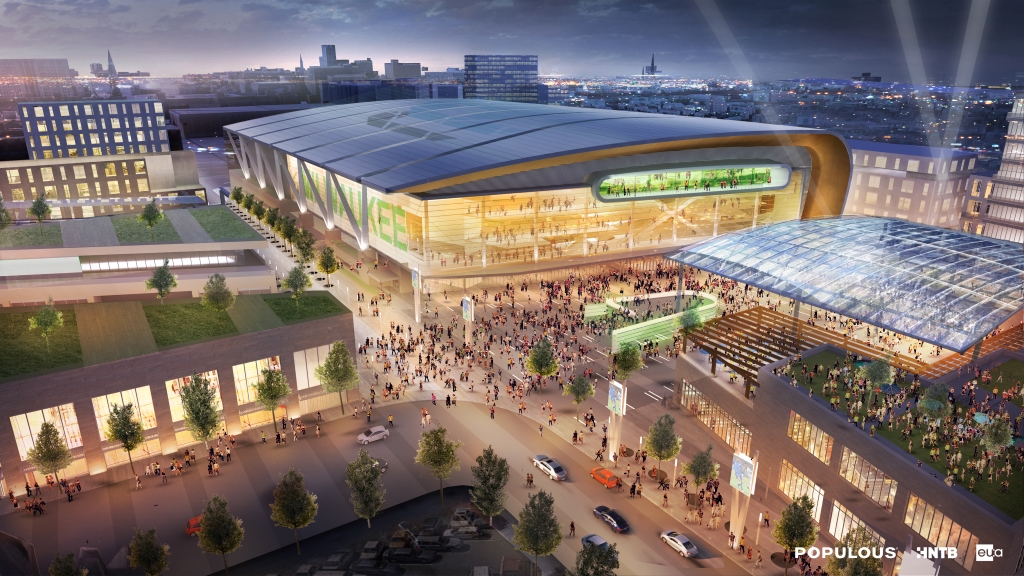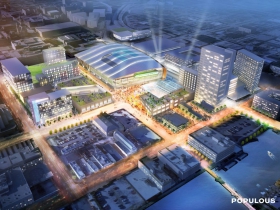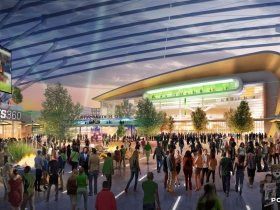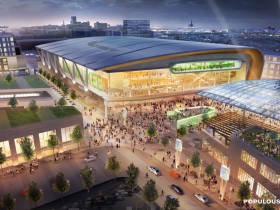A new funding approach is needed if we are going to retain the Bucks: The One Percent Solution
Statement of Alderman Robert Bauman
Having closely watched the debate over how to fund a new arena for the Milwaukee Bucks, it appears there is a real risk that this franchise will leave Milwaukee. It appears that the state legislature has balked at Governor Walker’s original $220 million funding proposal. It appears they are focused on approving a funding package of $150 million. This leaves a funding gap of at least $100 million ($500 million in projected cost, less $250 million in private capital and $150 million in state financing). State legislative leaders have suggested that the city and county come up with this $100 million or what could be an even bigger share if the actual costs of construction run over $500 million.
As far as the city is concerned, coming up with $50 million or more is simply not possible given existing financing tools at the city’s disposal. We cannot use our most effective tool—tax incremental financing—because the arena will be exempt from property taxes. The city has pledged approximately $25 million in assistance, mostly in the form of improved and unimproved real estate. However, contributing real estate does not help meet actual arena construction costs.
I suspect that state legislative leaders know all of this, so their proposal of $150 million in funding is intended to create a funding gap they know the city and county cannot fill. They have set up the city and county as the “fall guys” if the Bucks choose to leave.
A one-cent dedicated sales tax in Milwaukee County would completely cover the public share of arena construction costs, as well as ongoing maintenance (which no one has discussed in connection with current funding proposals), would completely fund all parks and cultural institution deferred capital projects, proposed capital projects and the Milwaukee County share of operating costs, and completely fund the Milwaukee County share of transit operating costs and proposed capital projects such as Bus Rapid Transit lines and expanded service to job centers in suburban areas.
This one-cent dedicated sales tax would represent new revenue, although there would be a significant Milwaukee County property tax offset since the Milwaukee County property tax levy is covering the local share of parks, cultural institutions and transit at present. This new revenue would enable Milwaukee County to retain one public good (the Bucks), and place three other public goods (parks, cultural institutions and transit) on a stable and sustainable financial footing for years to come. The constant debate about deteriorating parks, struggling cultural institutions and declining transit service would end.
State legislative action is required to implement this approach. This will represent a new tax. However, the legislature could require a Milwaukee County referendum. The legislature can put the question to the voters and let them decide whether the Bucks are worth keeping and whether stable and sustainable funding for parks, cultural institutions and transit are worth an extra cent in sales taxes.
This approach is not new. Most major metropolitan areas have dedicated sales taxes for transit, and at least one city, Oklahoma City, has used a dedicated sales tax to pay the public share of an NBA arena. Such dedicated taxes have usually been implemented after successful public referenda.
Yes, the Milwaukee County sales tax would increase to 6.6%, but this would still represent one of the lowest sales tax rates among major urban counties. In addition, the Milwaukee County property tax levy would be reduced by nearly $54 million dollars. The local cost to operate and maintain parks, cultural institutions and transit would shift from property tax payers to consumers of goods and services in Milwaukee County, of whom approximately 25 percent are non-residents.
I hope common sense and reason prevail, and that this proposal gets serious consideration in the legislature.
Arena Renderings
NOTE: This press release was submitted to Urban Milwaukee and was not written by an Urban Milwaukee writer. While it is believed to be reliable, Urban Milwaukee does not guarantee its accuracy or completeness.
Mentioned in This Press Release
Recent Press Releases by Ald. Bob Bauman
Alderman Robert Bauman statement regarding the Historic Preservation Commission’s recommendation to designate the Milwaukee Arena and Miller High Life Theater as Historic Sites
Nov 3rd, 2025 by Ald. Bob BaumanDesignation will ensure full transparency and require public input regarding future development proposed for the sites
Discovery World workers have our support
Sep 19th, 2025 by Ald. Bob BaumanSeptember 19, 2025 - Statement from Milwaukee Common Council Members: Alderman Alex Brower, Alderwoman Marina Dimitrijevic, and Alderman Robert J. Bauman

























This makes far too much sense. We might need one old grocery bag flattened out and one black crayon to explain this to some members of the legislature. Unfortunately by the time the WOW county residence realize that not only do they not have to pay for this, but no unwanted citizens will be encouraged to move to their neighborhood and the outstate representatives can be convinced that the Tea party will not be challenging their seats because they voted for a tax increase, the Bucks will be in Seattle.
I encourage everyone to call Tim Sheehy and tell him to support this. If he and his pals want this so much, the least they can do get something for Milwaukee County, even it won’t be a profit center for Edens and Co.
Well put Jeff. I’ll make that call.
Let’s add up what’s in this play:
The $450 million (over 30 years) Bruce Murphy estimates the Bucks will not not pay in property taxes is not part of the equation presented. (The rest of us pay more in property taxes to make up for it. Police, fire, garbage, utility services will still need to be provided for the 27-plus-acre project).
The city has offered to pay for millions in new infrastructure (for street changes, utility lines, etc.). It’s now estimated at $17.5M.
Then the public would pay at least half to build not just an arena, but also a separate block-long entertainment/bar complex. How much more will that add to the projected $500-million arena cost?) All of this will financially benefit solely a for-profit company, which now gets about 40-percent total cut of ALL Bradley Center concessions, suite leases, catering & merchandise sales (not just at their games).
To top it off, taxpayers would agree to pay for all the ongoing maintenance of these two huge facilities. It assumes the Bucks will continue to pay no rent, as in their current lease. Simply charging rent to Marquette, Admirals, & others hosting events, and charging already-steep ticket service charges, is not enough to pay arena overhead. Any sane landlord would flee from such a deal, but taxpayers are supposed to think it’s a great opportunity to “own” a building that cannot pay its way.
A sales tax to address the longtime deferred maintenance of Milwaukee County Parks (I’ve read $200-$300 million) and deferred maintenance and upgrades at the Zoo and county-owned museums and performing arts center (estimates vary) is certainly worth considering.
The key difference: None of these public and public-nonprofit entities is lining the pockets of a business now valued at $600 million. The museums etc. already are very lean and shaking the trees every way possible. Parks are beyond decrepit in many cases, and volunteers and donors keep many afloat, but these “friends” can’t spring for new roofs, bridge repairs, etc.
I’m glad someone is drawing attention to our parks and cultural needs. Every other business in town would probably like to have taxpayers help fund their expansion and upkeep. Experts say it’s enough for governments to provide businesses, includig sports teams, incentives of infrastructure and free land. The public will already pay for the planned arena site, which the state-owned Bradley Center authority bought/is buying. The Bucks have many income streams, including a TV deal that will give them $87M more a year. Our museums and parks have no such revenue options.
Public support for public assets can help spur economic growth and improve quality of life. I hope the Bucks stay, and pay their own way, like all other businesses do, including those providing sustenance & entertainment.
Alderman Bauman, I was also a member of that Cultural and Entertainment Needs Task Force, representing the 4,000+ businesses and nearly 70,000 individuals in the M7 region that are part of the creative economy. I appreciate that you have reminded us all that there are solutions out there that a thoughtful group of regional representatives dedicated a year to researching and recommending. Now it’s show time. Let’s get this done in a rational, logical way that enriches our community on multiple levels.
To M:
Your reply is very thoughtful; thank you. My question is this: How is it that, in a city with a very high level of property taxation, the claim is made that we cannot afford to take care of our parks, infrastructure, schools, and so on? Is it mismanagement or do we have extraordinarily costly needs for some reason?